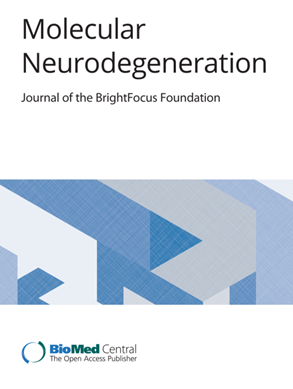sPLA2-IIA modifies progranulin deficiency phenotypes in mouse models
IF 17.5
1区 医学
Q1 NEUROSCIENCES
引用次数: 0
Abstract
Haploinsufficiency of the progranulin (PGRN) protein is a leading cause of frontotemporal lobar degeneration (FTLD). Mouse models have been developed to study PGRN functions. However, PGRN deficiency in the commonly used C57BL/6 mouse strain background leads to very mild phenotypes, and pathways regulating PGRN deficiency phenotypes remain to be elucidated. We generated PGRN-deficient mice in the FVB/N background and compared PGRN deficiency phenotypes between C57BL/6 and FVB/N backgrounds via immunostaining, western blot, RNA-seq, and proteomics approaches. We demonstrated a novel pathway in modifying PGRN deficiency phenotypes using inhibitor treatment and AAV-mediated overexpression in mouse models. We report that PGRN loss in the FVB/N mouse strain results in earlier onset and stronger FTLD-related and lysosome-related phenotypes. We found that PGRN interacts with sPLA2-IIA, a member of the secreted phospholipase A2 (sPLA2) family member and a key regulator of inflammation, that is expressed in FVB/N but not C57BL/6 background. sPLA2-IIA inhibition rescues PGRN deficiency phenotypes, while sPLA2-IIA overexpression drives enhanced gliosis and lipofuscin accumulation in PGRN-deficient mice. Additionally, RNA-seq and proteomics analysis revealed that mitochondrial pathways are upregulated in the PGRN-deficient C57BL/6 mice but not in the FVB/N mice. Our studies establish a better mouse model for FTLD-GRN and uncover novel pathways modifying PGRN deficiency phenotypes.sPLA2-IIA改变小鼠模型中的前颗粒蛋白缺乏表型
颗粒前蛋白(PGRN)单倍体不足是额颞叶变性(FTLD)的主要原因。已建立小鼠模型来研究PGRN的功能。然而,在常用的C57BL/6小鼠品系背景中,PGRN缺乏导致非常轻微的表型,调节PGRN缺乏表型的途径仍有待阐明。我们在FVB/N背景下产生PGRN缺陷小鼠,并通过免疫染色、western blot、RNA-seq和蛋白质组学方法比较C57BL/6和FVB/N背景下的PGRN缺陷表型。我们在小鼠模型中展示了一种使用抑制剂治疗和aav介导的过表达来修饰PGRN缺陷表型的新途径。我们报道,FVB/N小鼠品系的PGRN缺失导致发病更早,更强的ftld相关和溶酶体相关表型。我们发现PGRN与sPLA2- iia相互作用,sPLA2- iia是分泌磷脂酶A2 (sPLA2)家族成员之一,是炎症的关键调节因子,在FVB/N中表达,而在C57BL/6背景中不表达。sPLA2-IIA抑制可挽救PGRN缺陷表型,而sPLA2-IIA过表达可在PGRN缺陷小鼠中促进胶质细胞形成和脂褐素积累。此外,RNA-seq和蛋白质组学分析显示,线粒体通路在pgrn缺陷的C57BL/6小鼠中上调,而在FVB/N小鼠中没有上调。我们的研究建立了一个更好的FTLD-GRN小鼠模型,并发现了修饰PGRN缺陷表型的新途径。
本文章由计算机程序翻译,如有差异,请以英文原文为准。
求助全文
约1分钟内获得全文
求助全文
来源期刊

Molecular Neurodegeneration
医学-神经科学
CiteScore
23.00
自引率
4.60%
发文量
78
审稿时长
6-12 weeks
期刊介绍:
Molecular Neurodegeneration, an open-access, peer-reviewed journal, comprehensively covers neurodegeneration research at the molecular and cellular levels.
Neurodegenerative diseases, such as Alzheimer's, Parkinson's, Huntington's, and prion diseases, fall under its purview. These disorders, often linked to advanced aging and characterized by varying degrees of dementia, pose a significant public health concern with the growing aging population. Recent strides in understanding the molecular and cellular mechanisms of these neurodegenerative disorders offer valuable insights into their pathogenesis.
 求助内容:
求助内容: 应助结果提醒方式:
应助结果提醒方式:


